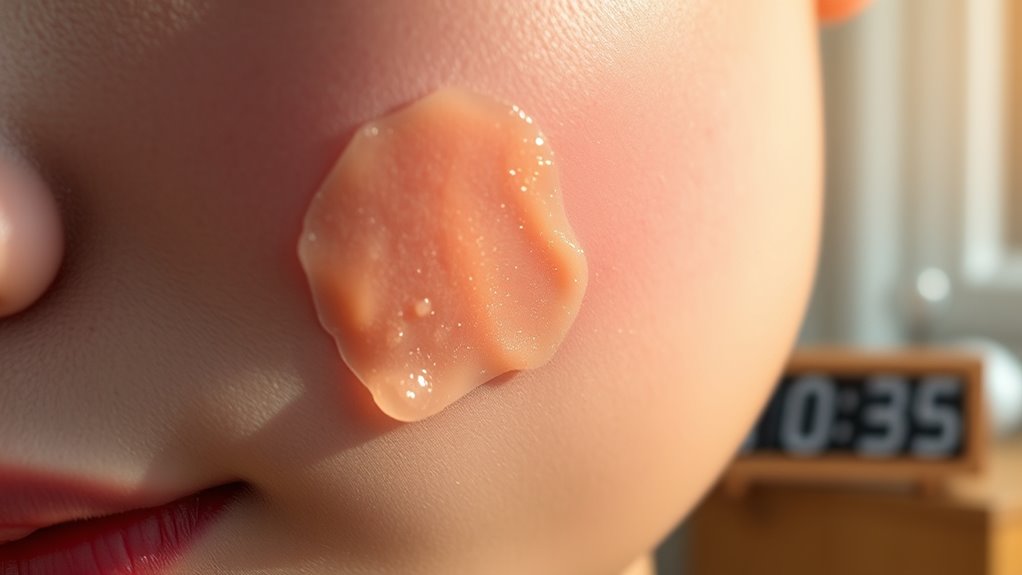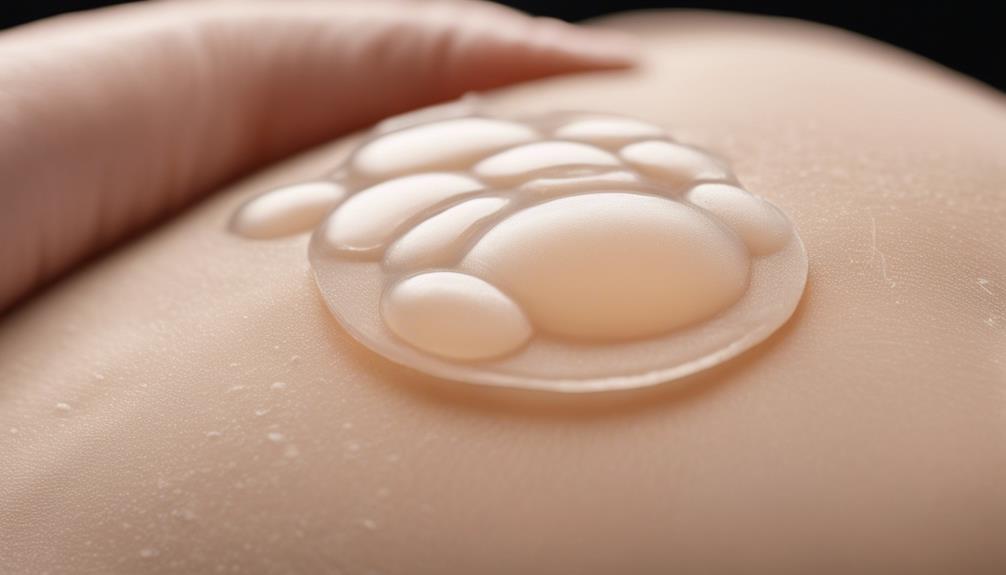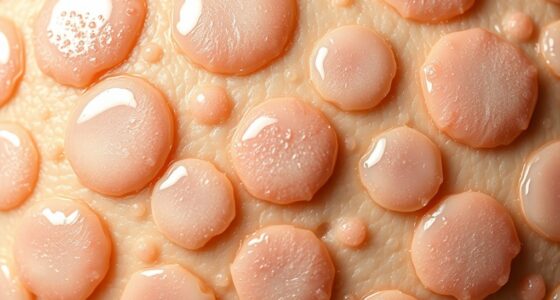Pimple patches can work surprisingly fast, showing visible improvements in just 4 to 8 hours for whiteheads. They create a moist environment that helps absorb impurities and reduces inflammation. For stubborn blackheads or cystic acne, you might need to use them longer for effective results. To get the most out of these little stickers, proper application is key. Stay tuned to discover more tips and tricks for maximizing their benefits!
Key Takeaways
- Pimple patches typically show noticeable improvement in whiteheads within 4 to 8 hours of application.
- Blackheads may require several days of consistent use for effective results.
- Cystic acne often necessitates extended wear for significant changes to occur.
- Patches with active ingredients like salicylic acid enhance speed in reducing inflammation and redness.
- Proper application on clean, dry skin maximizes the patches’ effectiveness and speed of results.
Understanding Pimple Patches: What They Are and How They Work

When you’re dealing with a pesky pimple, pimple patches can be a game changer. These small, hydrocolloid-based stickers protect your skin while absorbing excess fluid and impurities from superficial pimples like whiteheads. They act as a barrier against irritation and bacteria, preventing further damage and inflammation. You can wear them during the day or night, and their discreet design makes them hard to notice. Most patches are biodegradable and disposable, making them a convenient choice. Some even contain added ingredients like salicylic acid or tea tree oil to enhance their effectiveness. Additionally, they provide hands off protection by preventing you from picking at the blemish, which promotes faster healing.
The Science Behind Speed: How Pimple Patches Deliver Results
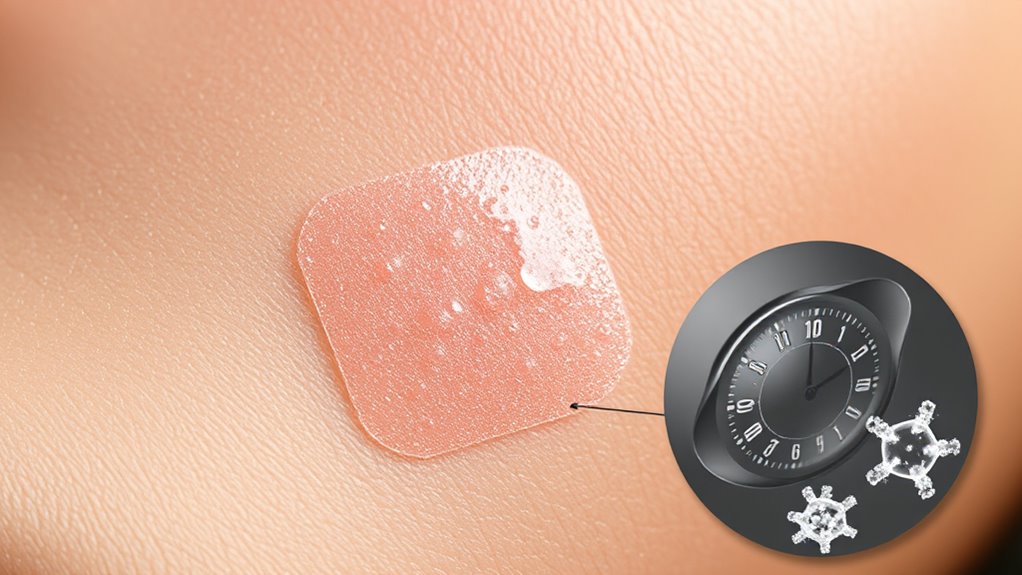
Although you might hope for quick relief from a pimple, understanding how pimple patches work can help you appreciate their effectiveness.
These patches use hydrocolloid to create a moist healing environment that absorbs pus and oil, speeding up recovery. They also reduce redness and inflammation while providing a protective barrier against bacteria. Hydrocolloid patches are designed to absorb excess fluid and protect acne lesions from external irritants.
Pimple patches harness hydrocolloid to absorb pus and oil, promoting healing while reducing redness and protecting against bacteria.
Active ingredients like salicylic acid and tea tree oil target acne-causing bacteria and unclog pores. Microneedling patches deliver these ingredients deeper for tougher cases.
While you may see results within hours, complete resolution takes longer. Factors like skin sensitivity or the type of pimple can affect outcomes.
Ultimately, selecting the right patch type can greatly influence how quickly you see improvements.
Timeframes for Different Types of Acne

Pimple patches offer varying results depending on the type of acne you’re dealing with. For whiteheads, you can see improvements in just 4 to 8 hours. Additionally, hydrocolloid material used in pimple patches helps absorb moisture and impurities, enhancing their effectiveness. Blackheads, however, may need several days of consistent use due to their deeper nature. Cystic acne often requires extended wear or multiple applications to notice any change. If you’re dealing with inflammatory acne, patches containing active ingredients like salicylic acid can help over time. Generally, surface-level blemishes respond faster than deeper ones.
Maximizing Efficacy: Best Practices for Use
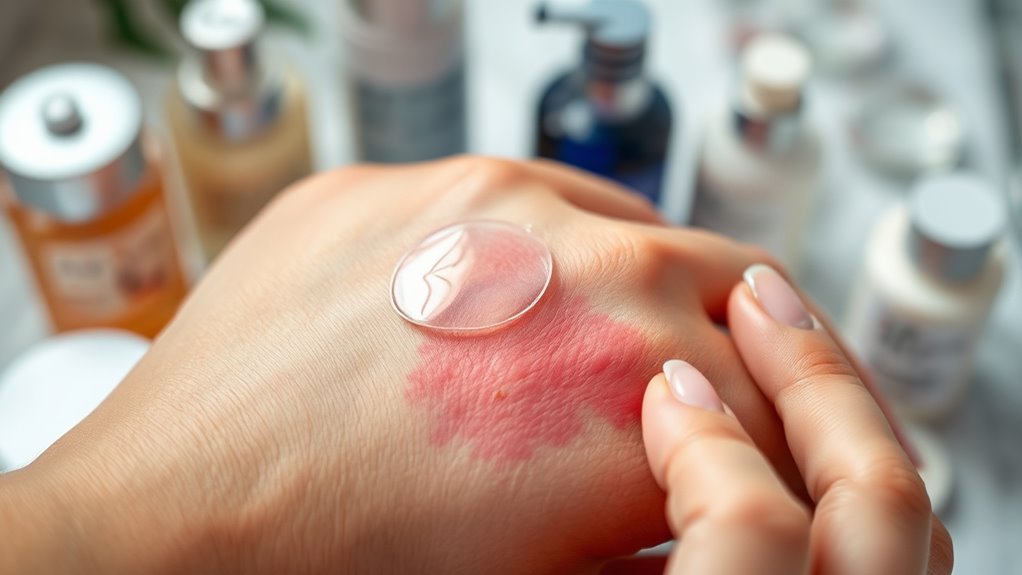
How can you guarantee your pimple patches work their best? Start by cleansing your skin thoroughly to remove dirt and makeup. A gentle exfoliation with a BHA toner can help unclog pores, boosting effectiveness.
Always apply patches on clean, dry skin—avoid rubbing, and pat your skin dry instead. Make sure your hands are washed before handling patches to prevent bacteria transfer. Always use clean hands when removing a pimple patch to avoid introducing germs.
Always use pimple patches on clean, dry skin, and ensure your hands are washed to avoid bacteria transfer.
Choose the right size patch for maximum coverage and consider your skin type; hydrocolloid patches are generally suitable for most.
Apply the patch directly onto the pimple, pressing firmly for 10-15 seconds. For best results, wear it for 6-8 hours, replacing it if it gets dirty or loses adhesion.
Follow up with a gentle skincare routine for healing.
Active Ingredients That Boost Speed and Effectiveness
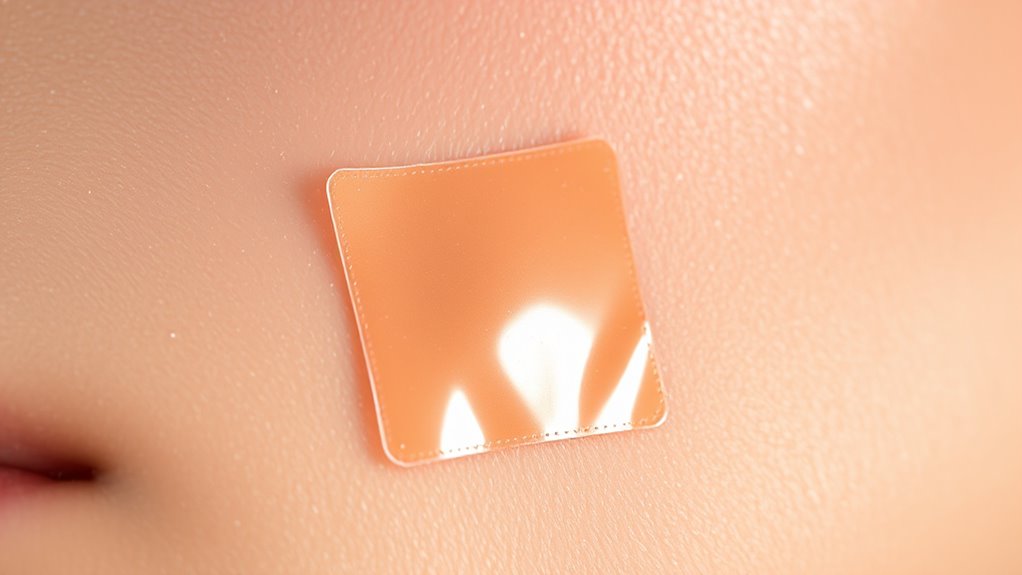
When it comes to maximizing the effectiveness of pimple patches, incorporating active ingredients can make a significant difference in your acne treatment.
Salicylic acid is great for exfoliating and unclogging pores, while benzoyl peroxide targets bacteria and reduces inflammation. If you want to minimize pore size, niacinamide is your go-to ingredient.
For an antibacterial boost, tea tree oil works wonders against acne-causing bacteria. Additionally, hyaluronic acid can provide hydration, especially in microneedling patches. Pimple patches are particularly effective for superficial pimples and work best when applied at the right stage of the blemish.
These active ingredients not only speed up healing but also help prevent future breakouts by keeping pores clear. By choosing patches with these components, you can enhance your acne management and achieve faster results.
The Role of Hydrocolloid in Rapid Healing
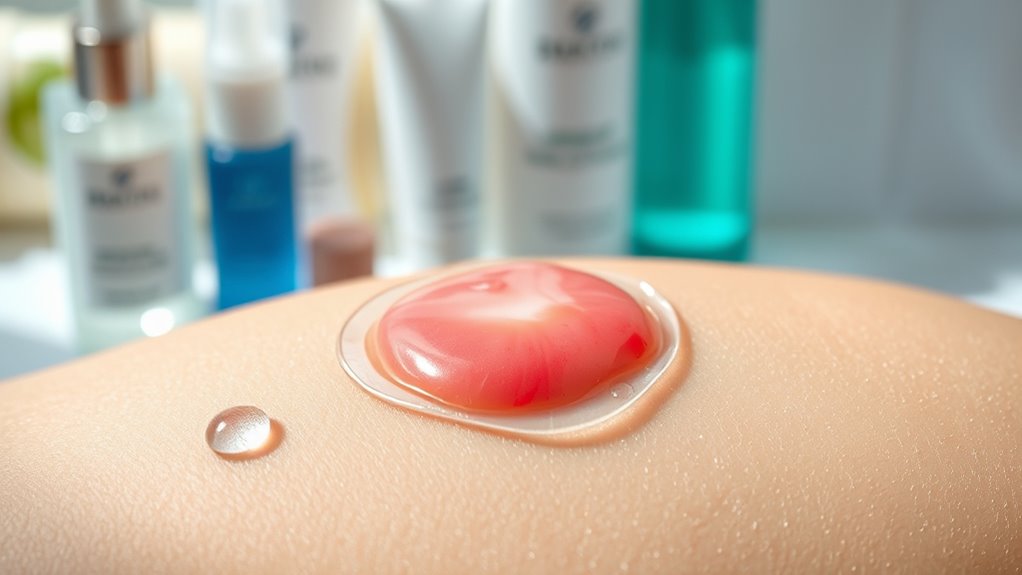
Hydrocolloid plays a pivotal role in enhancing the healing process for acne. These patches absorb excess oil and pus, creating a moist environment that speeds healing and reduces scarring risks. By forming a protective barrier, hydrocolloid shields your pimples from contaminants and bacteria, lowering infection chances. Plus, they minimize friction from daily activities, preventing irritation that can worsen your acne. The low-oxygen environment they create also hampers the growth of acne-causing bacteria in the skin. With hydrocolloid patches, you’ll notice accelerated pus extraction and reduced inflammation, along with less redness and swelling. They even help prevent scab formation, ensuring your skin heals faster and more effectively.
Comparing Overnight Results: What to Expect
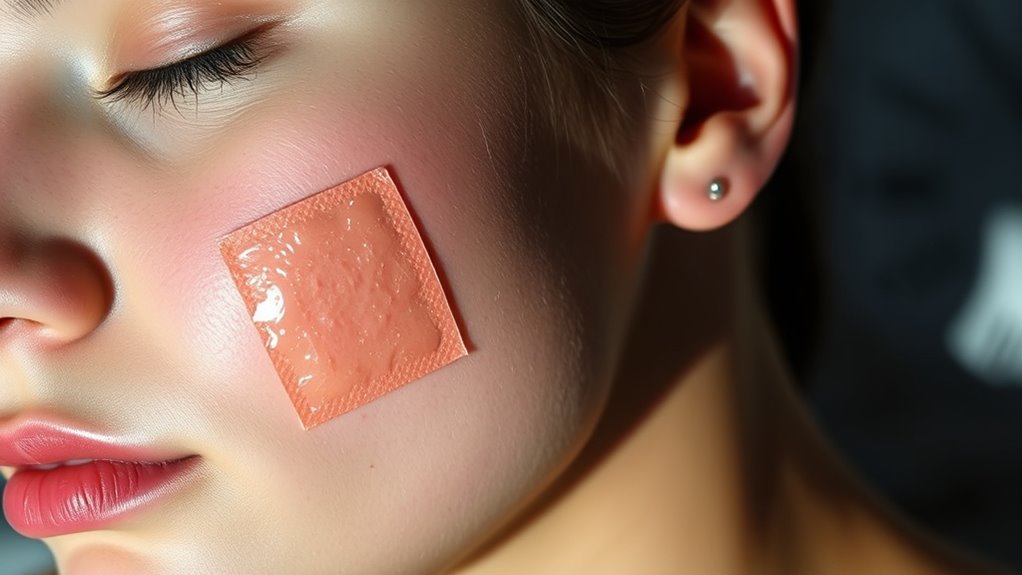
What can you expect from using pimple patches overnight? When you apply these patches before bed, you’ll likely wake up to noticeably reduced pimples, especially whiteheads.
Leaving them on for 8-12 hours aligns with your skin’s natural repair process, enhancing their effectiveness. Hydrocolloid patches work quickly by absorbing fluid, while those with active ingredients like salicylic acid may take a bit longer. To ensure optimal results, remember that pimple patches are designed to create a protective barrier that absorbs excess fluid and reduces inflammation.
If you have deeper blemishes, microneedle patches can deliver ingredients more effectively. Remember, consistent overnight use leads to better results over time.
Just make sure your skin is clean and dry before applying, and replace patches if they become saturated. With these tips in mind, you’ll see quicker improvements in your acne!
Factors Influencing the Speed of Results

Although various factors play a role in how quickly you see results from pimple patches, the type of patch you choose is one of the most crucial.
Medicated patches, containing salicylic acid or benzoyl peroxide, usually work faster on inflamed pimples. Hydrocolloid patches are gentler, promoting healing by absorbing excess oil but may take longer for ideal results. Hydrocolloid patches absorb impurities, making them ideal for whiteheads. Microneedling patches deliver active ingredients deeper for cystic acne, which can also speed things up. Additionally, applying patches on clean, dry skin enhances adhesion and effectiveness.
Medicated patches with salicylic acid or benzoyl peroxide offer quicker relief for inflamed pimples, while hydrocolloid patches promote gentle healing.
The right size and shape, along with good adhesion quality, greatly impact how well the patch performs. Remember, timing and duration of use also matter, especially for surfaced pimples.
When to Seek Alternatives for Stubborn Acne
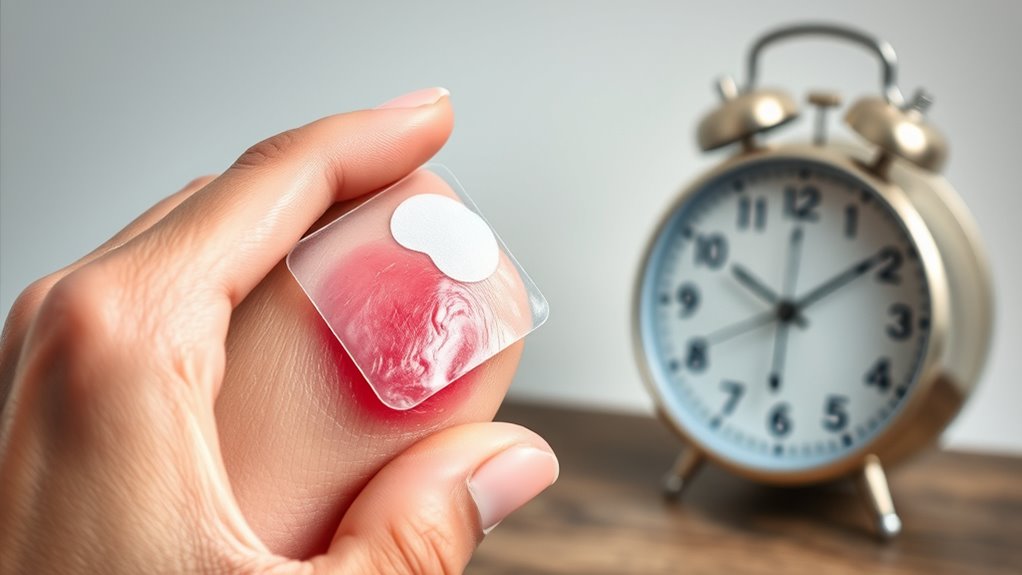
When stubborn acne persists despite using pimple patches and over-the-counter treatments, it may be time to explore alternatives.
Consider topical treatments like benzoyl peroxide or salicylic acid, which can help reduce bacteria and unclog pores. In addition, hydrocolloid patches are recommended for localized treatment and can complement these topical solutions. If you’re looking for something stronger, retinoids like adapalene can prevent new breakouts and are available without a prescription. Additionally, incorporating a low glycemic diet may help reduce insulin levels that impact acne severity. Regular use of products containing glycolic acid can also improve skin texture and clarity, aiding in acne management.
For more severe cases, consult a dermatologist about oral antibiotics, such as tetracyclines, which tackle bacteria and inflammation but come with potential side effects.
Don’t forget lifestyle changes—eating a balanced diet, avoiding processed foods, and staying hydrated can enhance skin health.
Natural remedies like tea tree oil or green tea might also provide relief. Always choose what suits you best!
Frequently Asked Questions
Can Pimple Patches Be Used on Other Skin Irritations?
You might wonder if pimple patches can be used on other skin irritations.
While they’re primarily designed for acne, some patches may help with minor blemishes by preventing irritation and picking.
However, they’re not typically effective for conditions like eczema or rosacea due to different skin needs.
If you’re considering them for other issues, it’s best to consult a dermatologist to guarantee you’re choosing the right treatment for your skin type.
Are Pimple Patches Safe for Sensitive Skin?
Imagine your skin as a delicate flower, needing gentle care. Pimple patches can be safe for sensitive skin, especially those designed like Neutrogena’s hydrocolloid options.
They’re gentle and fragrance-free, with 80% of users reporting no irritation. Just like tending to a flower, prepare your skin by cleaning it first, and test a small area to guarantee you won’t react.
With the right precautions, you can enjoy their benefits without fear.
How Many Patches Can I Use at Once?
You can use multiple pimple patches at once, but make sure each one fits its respective pimple perfectly.
Applying patches on clean, dry skin helps them stick better and work effectively.
Avoid overlapping them to prevent irritation, especially if you have sensitive skin.
If you’re treating a large pimple, you might need more than one patch, but be cautious not to overdo it to avoid any adverse reactions.
Do Pimple Patches Expire?
Pimple patches are like tiny shields in your skincare arsenal, but do they’ve an expiration date?
While hydrocolloid patches can last for years, they may lose their stickiness over time. If they contain active ingredients, their potency can fade.
To keep them effective, store them in a cool, dry place and check for any expiration dates. Using them within three to five years is your best bet for ideal results.
Can I Wear Makeup Over Pimple Patches?
Yes, you can wear makeup over pimple patches!
Just make sure your skin is clean and dry before applying the patch. Use lightweight makeup to maintain the patch’s effectiveness and blend gently to avoid dislodging it.
Pimple patches not only conceal blemishes but also protect them from irritants. This combination helps promote healing while giving you a smooth surface for makeup application.
Remember to avoid heavy layers to keep everything intact!
Conclusion
So, you thought pimple patches were just a cute accessory for your skincare routine? Surprise! They can actually work wonders in speeding up your acne recovery. While they might not turn you into a flawless model overnight, they definitely help reduce redness and size faster than you’d think. Just remember, patience is key—after all, good things come to those who wait, right? But who has time for that when your next selfie is just a patch away?
